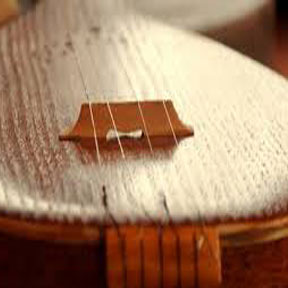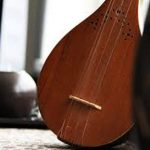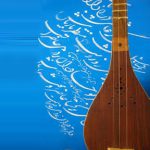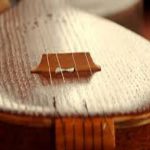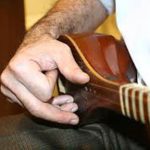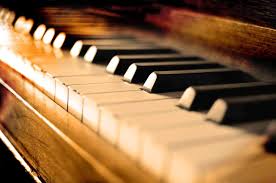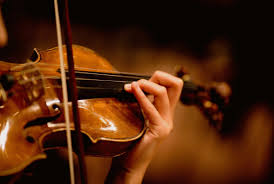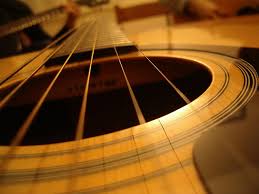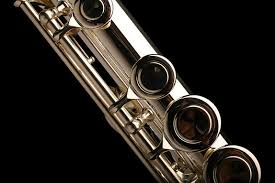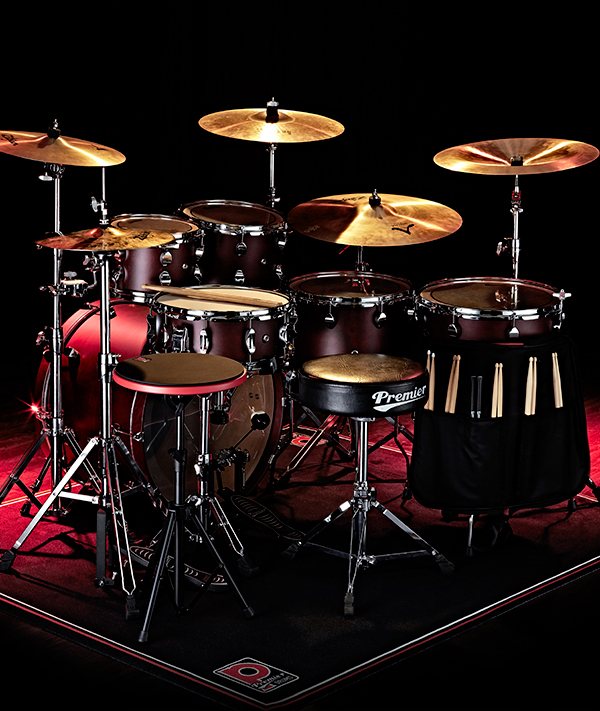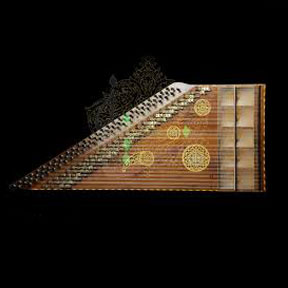History
The setar is a fretted plucked string instrument made from wood, metal, and gut or nylon strings. It is considered a descendant of the tanbur and, today, is more closely related to the tar. Many tar players are also familiar with playing the setar. The setar is played in a seated position, with the instrument placed horizontally on the thigh, the neck on the left side, and the soundbox on the right side of the player. The player moves the fingers of the left hand along the frets and plucks the strings with the nail of the right-hand index finger. Due to its light weight, the setar can also be played while standing.
Other Characteristics
The setar also uses specific conventional symbols, similar to the tar, with the difference that, unlike the tar, the right-hand stroke is played from down to up, and the left-hand stroke is played from up to down. The setar is used in both solo and ensemble performances and shares similar capabilities with the tar.
Physical Structure
Soundbox (Resonator): The soundbox is pear-shaped and made of wood, with a wooden plate covering its open end. Sometimes, the soundbox is made from a single piece of wood, while other times it is constructed from joined wooden strips. For aesthetic purposes, the soundbox may be decorated with inlays of bone or mother-of-pearl.
Top Plate: The top plate of the setar is made of wood, and small holes are usually made in it to allow sound to escape from the resonator.
Bridge: The bridge is also made of wood, approximately 4 centimeters long and 7 millimeters high. It is placed flat on the top plate. Shallow grooves are made on the bridge to guide the strings and keep them separate.
Neck: The neck of the setar is narrower than the soundbox and is a solid wooden tube about 2.5 centimeters in diameter and 45 to 50 centimeters long. The front of the neck, where the strings are pressed, is flat, while the back is semi-circular. Frets are tied along the length of the neck. The neck is connected to the soundbox at one end and to the headstock at the other. Sometimes, decorative bone inlays are added along the neck for aesthetic purposes.
Headstock: The headstock is made of wood and is located at the top of the neck, with four tuning pegs, two on each side. In some setars, the headstock is hollowed out, similar to the tar, allowing the strings to be attached internally. In other designs, the headstock is a solid extension of the neck, with the strings wound around the external tuning pegs.
Tuning Pegs: The tuning pegs are made of wood and shaped like thick-headed nails. The thinner end of the peg fits into the solid wood of the headstock, while the wider end, used for tuning, extends outwards. The strings are wound around the thinner part of the pegs. To prevent the strings from slipping off the nut, a piece of gut or nylon is sometimes tied around the strings just above the nut.
Nut: The nut is a narrow, low piece of wood placed between the neck and the headstock, about 4 millimeters high, with shallow grooves for the strings to pass through on their way to the tuning pegs.
Frets: The fretting of the setar is similar to that of the tar, with frets made from gut or nylon. The setar typically has 28 frets, tied in groups of three or four. The frets can be adjusted slightly for different musical modes.
Tailpiece: The tailpiece is a small piece of wood or bone attached to the end of the soundbox, where the strings are tied.
Strings and Material: The setar has four metal strings of varying thickness. It is said that the fourth, bass string was added by a dervish setar player named Moshtagh Ali Shah, and older players refer to it as the “Moshtagh” string. The thickness of the first and second strings is around 0.20 mm, the yellow string (third string) is around 0.22 mm, and the bass string is 0.36 mm or 0.38 mm thick.
Range: The typical range of the setar’s sound is close to three octaves.
Tuning: The tuning of the strings can vary depending on the musical mode being played, especially the third and fourth strings.
Notation: The setar is notated using the treble clef (G clef).
Plectrum: The setar is played with the nail of the right-hand index finger. Sometimes, a synthetic nail or a ring with an attached horn or nylon extension is used to pluck the strings.

